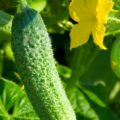Potatoes are a variety of diseases, among which the most common and the most dangerous is the blight. Phytophthora in potatoes is difficult to eradicate, but also to cope with the disease can be, if in time to take preventive measures.
How to deal with late blight in potatoes, how to prevent the disease, and what to do, if the infection has already occurred?
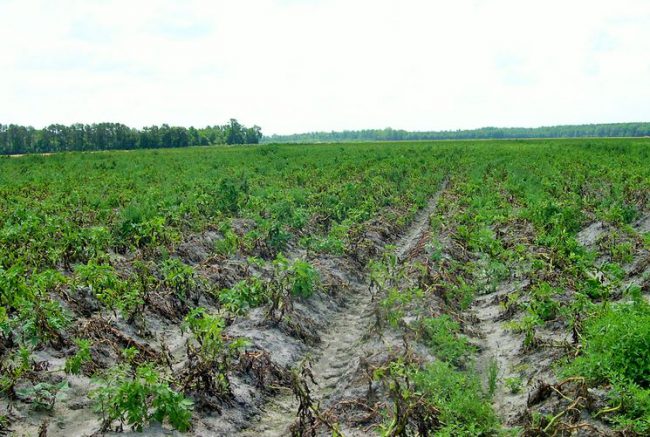
What is late blight and how it looks
Late blight is driven by a microscopic parasite (Phytophthora), which is usually found in the nightshade family plants and flowers. But most of all suffered from the disease Potatoes - because of the fungus completely or partially die stems and foliage, damaged and grows tubers.
Potatoes are more susceptible to the disease due to long growing season, that is, the plant may be infected by fungus since the beginning of flowering, but often the infection occurs already during harvest.
Fungus progresses very quickly and can destroy a significant part of the harvest for 2-3 weeks. but, infection occurs gradually and timely measures taken can save the situation, but if you miss the point, the late blight can cause an epidemic among plants.
note! Phytophthora longer lives in the affected area, the faster dissemination, and the harder it becomes a person cope with the fungus.
Infection begins with the bottom of the foliage, after which the mycelium starts to grow rapidly, spreading and infecting new disputes all around. infection source may be in the soil and, which was infected potatoes, and planting material. But the most dangerous fungus spores, which quickly spread by wind.
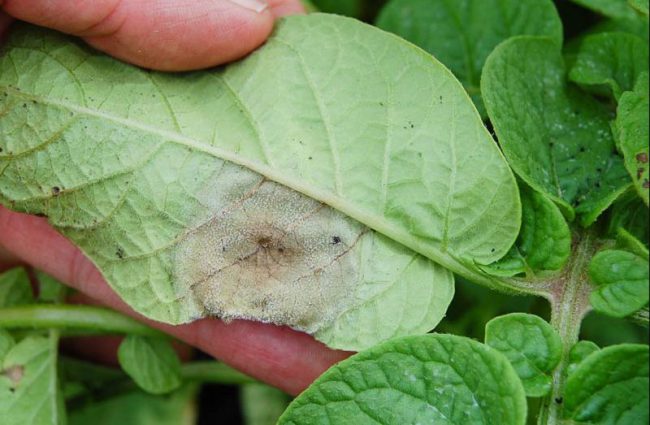
How to find late blight in potatoes:
- Bottom leaves at the beginning of mass flowering appear dark brown leaves with gray bloom.
- Dark brown spots on the leaves are rapidly increasing in size.
- Gradually the leaves turn black and die.
- Tubers appear dark areas affected tissues, which quickly harden.
- Inside potato tubers look "rusted".
The incubation period infection and spread of the disease depends on many factors related - Temperature, humidity, the degree of infestation, resistant varieties. Most often the disease is activated in the second half of the summer, although in southern blight often occurs at the beginning of the warm season.
connection requires two factors for the development of late blight - presence of pathogenic spores and favorable environmental conditions:
- The fungus is growing rapidly in a moist environment, Humid (over 75%). Even in the absence of rain dampness may cause abundant glaze, fogs, morning dew.
- Comfortable for the development of mold temperature - +15-+22 degrees.
Important! When dry weather and temperature over +27 degrees infection spreads slowly.
Also Phytophthora spreads rapidly, if planted too heap nightshade.
How dangerous blight:
- Due to the early death of foliage do not have time to form high-grade tubers.
- Often affected themselves tubers, which leads to lower consumer qualities, and often to the death of the crop.
- Phytophthora favors the development of rot in the tubers.
- the need for processing of affected areas chemicals degrades the environment, It contributes to the accumulation of harmful substances in vegetable crops.
fungus danger also is, he was quietly going through the winter in the soil and spring striking new crops. For the complete destruction of the pathogen Phytophthora may need two to five years. In this case, on the ground should always be carried out special processing using the popular and chemicals, and also observe certain rules agrotechnics.
Plan to combat late blight
The fight against pathogenic fungus continues throughout the year, so you need to have a clear plan of action, to defeat this dangerous disease.
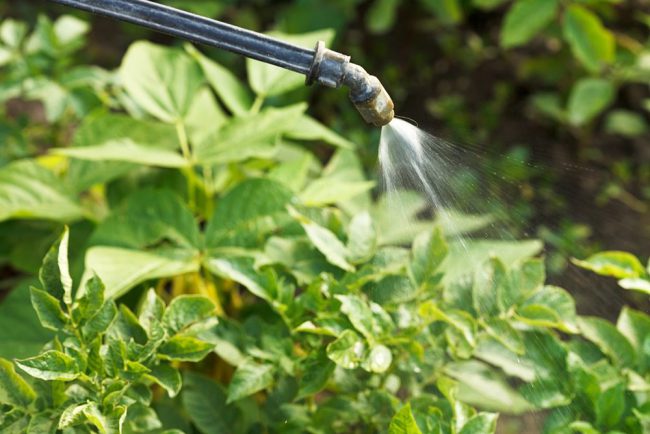
How to deal with Phytophthora:
- Prepare beds in late autumn: remove the remains of plants, dig ground using fungicides.
- The store regularly to sort out potatoes, sort it, wire processing space.
- Spring treat soil chemical or folk remedies, Perekopa land.
- Before planting, treat the plant material with fungicides or folk remedies.
- Two weeks after landing to spend a first treatment chemicals.
- When the seedlings to spend mulching flower beds or treat the soil with lime powder.
- every two weeks before flowering conduct the processing of the selected drug. it is recommended not to change the chemicals, can only rotate them with folk remedies.
- The flowering period is only used for the treatment of benign folk remedies.
- After flowering, pay attention to the treatment of the lower parts of the plant, spend watering special solutions.
- After digging up potato tubers to dry and sort out.
- If you plan to store potatoes, the room is recommended to carefully handle.
note! The last treatment should be carried out no later than, than 20 days before harvest.
For primary prevention Phytophthora carried tuber treatment (eg, using potassium-phosphate formulations). Spud potato should be a "pyramid", ie. moisture should flow into the groove from the center of the bush. Watering planting should be carried out only when necessary, and "rain" method, and using a hose.
If late blight is already in the active stage, then treat it by any means have to be useless. In this case it is necessary to localize the lesion and prevent the process of movement of spores of the fungus to healthy bushes. To do this, use the following methods:
- After dropping the culture must wait, to tops grew to about 25-30 cm, and begin the first stage of processing (commonly used drug "Ridomil").
- Before flowering spray the plant preparation "Appin". A potato resistant varieties are used for spraying "krezatcina", "Immunotsitofat", "Silk".
- If the process is not much running spray used drugs "Revus" or "Consent".
Upon detection of infected plants, you should immediately remove it from the site and choose the tubers, and burn the tops. Also be handling all the tools, a strong solution of working clothes and footwear of potassium permanganate or copper sulfate.
Delayed planting potatoes or seeds should be checked, remove the damaged tubers, and the remaining material was carefully treated with special disinfectants (Dita, TMTD, formalin, et al.).
chemical agents
Without the use of complex chemical protection combating Phytophthora will be useless. But it does not mean, that the next harvest will be hazardous to health - properly selected and cash judicious application will help preserve the ecological purity of products.
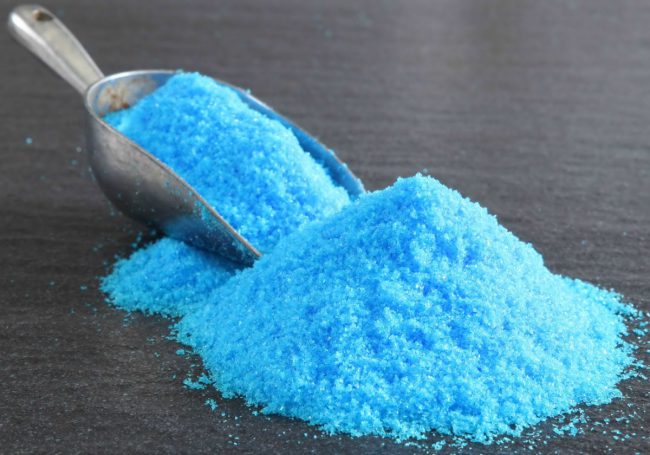
Popular drugs to fight blight:
- Bordeaux mixture (or Bordeaux mixture). It used to combat fungi and various infections, It helps to shape and develop plants. Bordeaux mixture is processed entirely whole plant (1 liter on 10 quarter. of planting). spraying speed is controlled independently, but should not during the growing season to be more 14 spraying with a gap therebetween not less 1-1,5 weeks.
- Oksihom or HOM. It helps prevent fungus, but can not cure the blight. Safe for the environment, It can be used up to three times per season, but it is forbidden to use during the flowering period.
- Arcerid. During the season, the frequency of sprays should not exceed three times.
- Ridomil God MC. Treatment should be performed at least three times, with an interval of 1,5-2 of the week.
After treatment with one of the formulations be viewed through the bushes 8-15 days after spraying. If the risk of infection will be at the same level, it is necessary to move on to more powerful drugs - "soon", 'Ditan', "Revus", "Ef'al Regional Council".
note! Considered the safest means of bio-fungicides, created on the basis of live microorganisms: Fitosporin, Gamair, Trichoderma Veridia, Alirin.
Preparations based on copper (raw, oksihom, bluestone, Bordeaux mixture) suitable for prophylactic treatment (before flowering period and the active build-up tubers), in the interim (After flowering and during flowering) These funds are virtually useless.
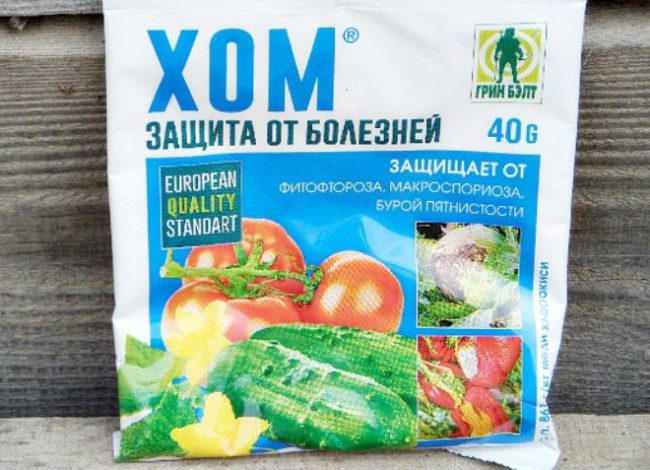
The copper-containing agents are quickly washed away by rains, and therefore they are less effective, than modern fungicide preparations - Consent and Revus. These funds do not lose their properties during rainy weather, rapidly decomposes in the soil and are less toxic to living organisms. They are used not more than four times per season, with an interval of 1,5-2 of the week.
Selected products from Phytophthora should not be changed during the season, but the next year to choose the best new tools, tk. fungus quickly adapts to various methods to deal with it.
picking fungicides, Carefully study the instructions for use. If the drug is designed to combat late blight, this does not mean, that you can use it at any time - some agents are designed to protect young shoots, while others are used only in the later stages of plant growth.
folk ways
Most often gardeners have resorted to the popular methods of combating blight, tk. They do not want to "poison" his harvest chemistry. But keep in mind, home remedies that can help only to late blight resistant potato varieties and apply them should be regularly and frequently (2-4 once a month).
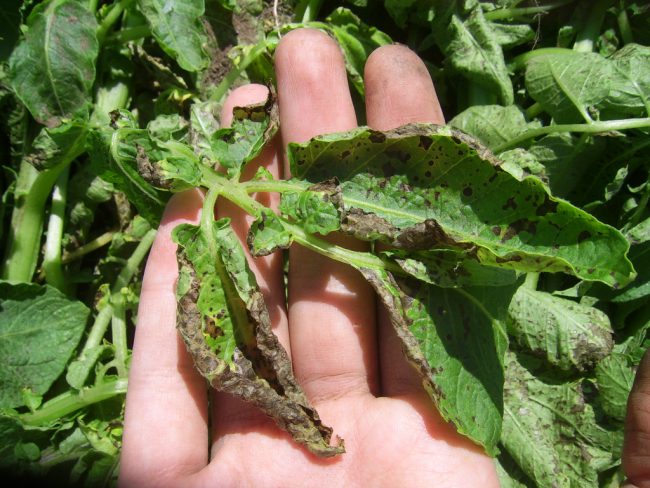
Folk remedies for Phytophthora:
- wood ash: sprayed repeatedly - through 15 days after germination, and then - on the buds after three weeks. Infusion: at 10 liters of water diluted with two liters of ash, infuse for three days, after the filter and add 50 g soap.
- Garlic tincture - use for 30 days at intervals of 5-7 days (the total number of sprays - 4 fold). Infusion: chop 100 grams of garlic and add to 10 liters of water, to insist within days, strain and spray the plant.
- Serum: apply once a week, with a strong infection - once in three days. Infusion: serum diluted with water in proportion 1:1.
- A solution of copper sulfate - used, as a landing ground in, and during the potato cultivation. The interval between sprinkles should be at least 10 day. Infusion: ten liters of water to dissolve the drug tablespoon (20 g) and process potatoes. During the flowering of vitriol treatment should be abandoned, and instead apply a weak solution of potassium permanganate.
- Skim milk or yogurt perekisshy - Treat each 7-14 days. Infusion: One liter of milk or yogurt diluted in a bucket of water and drip 15 drops of iodine.
- Trihopol - effective against the fungus due to the active substance metronidazole. It is used for processing and spraying of plants, as well as under watering (50 ml for each bush). Solution: 10 tablets dissolve in a bucket of water, add to the effectiveness of 20 iodine drops or bubble green fodder.
note! To be most effective folk remedies can be combined with biological fungicides stores.
Protect against phytophthora potatoes helps mulch with sawdust, agrovoloknom, lime or newspapers. Due to such processing on the lower part of the plant is reduced heating, and fungus does not apply.
How to prevent late blight: preventive actions
With late blight is very difficult to fight, so it is easier to prevent the emergence and spread. To do this, you need to perform certain agrotechnical measures, and in the season to spend 3-4 preventive spraying.
Tips agricultural technicians:
- Before planting, select healthy seed. Good warm up the tubers in the open air at a temperature 15-18 degrees. If after warming up on the tubers appear spots, they should not be used for sowing.
- Not to plant potatoes heap.
- Avoid nisin and at planting potatoes planted on a flat surface, tk. in the lowlands it is usually marked by increased humidity.
- Spend a good soil drainage before planting. Regularly weed and loosen the soil.
- Desirably potatoes planted in soil, where previously grown perennials (corn, linen, beet). In the spring, these plants mow and dig for 2-3 weeks before planting, together with the soil.
- Avoid shady areas. Choose places with good lighting and provetrivaemostyu.
- Away from the potatoes to plant such crops, like pepper, tomatoes and eggplants. Closer can be arranged beds with mustard and radish.
- Fertilize the soil phosphorus and potassium fertilizers or wood ashes. Nitrogen fertilizer is better to limit.
- After digging out a thorough drying and Potatoes. In identifying the affected plants, it is better to burn.
- For the prevention of late blight of potato varieties is important to use, resistant to this pathogen. These classes are: Spring, Holubyzna, Nevsky, Luck, Red Scarlett.
Save the potato crop from Phytophthora can, using complex event - the disease can not be cured, but it is possible to prevent its occurrence and to suspend the development of late blight in the area with the help of modern and folk remedies.



